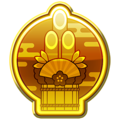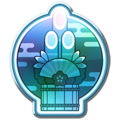Kadomatsu: Difference between revisions
mNo edit summary |
m (Text replacement - "(\| *)Jap([RMCN\d]* *=)" to "$1Jpn$2") |
||
| (53 intermediate revisions by 17 users not shown) | |||
| Line 1: | Line 1: | ||
[[File:MKT Kadomatsu.png|thumb| | {{image|more=yes|locations that they appear in, similar to [[Festive tree]]'s location section}} | ||
'''{{wp|Kadomatsu}}''' are traditional Japanese New Year decorations that are said to attract good luck. They consist of several tree cuttings, mainly bamboo stalks and pines, bound together with straw rope. | [[File:MKT Icon Kadomatsu.png|thumb|Official render of a kadomatsu]] | ||
'''{{wp|Kadomatsu}}''' are traditional Japanese New Year decorations that are said to attract good luck. They consist of several tree cuttings, mainly bamboo stalks and pines, bound together with straw rope. In ''[[Mario Kart Tour]]'', kadomatsu are added to courses in tours that occur around the New Year, being similar in function to the [[festive tree]]s that appear in holiday tours. They have appeared in the following tours: | |||
*[[New Year's Tour (2020)]] | |||
*[[New Year's 2021 Tour]], starting from January 2021 | |||
*[[New Year's 2022 Tour]], starting from January 2022 | |||
*[[New Year's Tour (2023)]], starting from January 2023 | |||
Kadomatsu are placed around arches, entrances and [[Finish | Kadomatsu are placed around arches, entrances and [[Finish line (object)|finish lines]] and are usually colored white with a single Japanese character. When a driver gets near a kadomatsu, they can hear a dulcimer. Generally, kadomatsu bounce and give bonus points when hit with an offensive item or when driven into while [[Invincible Mario|invincible]] or [[Mega Mario|Mega]], with the action being displayed as "Happy New Year!"; since the New Year's 2022 Tour, it also gives an [[event token]]. However, in the New Year's 2021 Tour, hitting a kadomatsu did not grant bonus points, display the action, or give event tokens. | ||
==List of course appearances== | |||
*[[Tour Tokyo Blur|Tokyo Blur 2, R, T, R/T]] | |||
*[[RMX Rainbow Road 2|RMX Rainbow Road 2, R, T]] | |||
*[[SNES Mario Circuit 1|SNES Mario Circuit 1, R, T, R/T]] | |||
*[[SNES Donut Plains 1|SNES Donut Plains 1, R, T]] | |||
*[[SNES Mario Circuit 2|SNES Mario Circuit 2, R, T]] | |||
*[[SNES Mario Circuit 3|SNES Mario Circuit 3, R, T]] | |||
*[[SNES Vanilla Lake 1|SNES Vanilla Lake 1, R, T, R/T]] | |||
*[[N64 Kalimari Desert|N64 Kalimari Desert, R, T, R/T]] | |||
*[[GBA Sky Garden|GBA Sky Garden R/T]] | |||
*[[GCN Dino Dino Jungle|GCN Dino Dino Jungle, R, T]] | |||
*[[DS Luigi's Mansion|DS Luigi's Mansion, R, T]] | |||
*[[DS Waluigi Pinball|DS Waluigi Pinball, R, T, R/T]] | |||
*[[DS Airship Fortress|DS Airship Fortress, R, T]] | |||
*[[3DS Shy Guy Bazaar|3DS Shy Guy Bazaar, R, T, R/T]] | |||
*[[3DS Neo Bowser City|3DS Neo Bowser City R/T]] | |||
*[[3DS Rosalina's Ice World|3DS Rosalina's Ice World, R, T]] | |||
==Profiles== | |||
===''Mario Kart Tour''=== | |||
*'''''Mario Kart Tour'' Twitter:''' ''Japan's most famous city is back for for another lap with the Tokyo Blur 2 course. Those traditional kadomatsu decorations aren't just for show—hitting them with an item is a great way to rack up some extra points!''<ref>mariokarttourEN (January 1, 2020). [https://twitter.com/mariokarttourEN/status/1212523902674583553 ''Twitter'']. Retrieved July 28, 2021.</ref> | |||
{{Multilang profile | |||
|columns=1 | |||
|type=''Mario Kart Tour'' FAQ description | |||
|Eng='''What is a kadomatsu?'''<br>A kadomatsu is a decoration for the New Year in Japan made from bamboo.<br>They appear on courses for several days starting with the first day of every year, so see if you can track them down!<ref>[https://faq.mariokarttour.com/hc/en-us/articles/13758723692441-What-is-a-kadomatsu-# What is a kadomatsu?] faq.mariokarttour.com (English). Retrieved January 2, 2024. ([https://archive.ph/yA4Ca Archived] December 31, 2022, 15:29:20 UTC via archive.today.)</ref> | |||
|SpaA='''¿Qué son los adornos festivos de bambú?'''<br>Los adornos festivos de bambú son decoraciones tradicionales japonesas de Año Nuevo que aparecerán durante unos días en las pistas a partir de principios de año. ¡A ver si los encuentras!<ref>[https://faq.mariokarttour.com/hc/es-es/articles/13758723692441--Qu%C3%A9-son-los-adornos-festivos-de-bamb%C3%BA-# ¿Qué son los adornos festivos de bambú?] faq.mariokarttour.com (European Spanish). Retrieved January 2, 2024. ([https://archive.ph/Q2vAl Archived] January 2, 2024, 14:57:27 UTC via archive.today.)</ref> | |||
|SpaE='''¿Qué son los adornos festivos de bambú?'''<br>Los adornos festivos de bambú son decoraciones tradicionales japonesas de Año Nuevo que aparecerán durante un tiempo en los circuitos a partir de principios de año. En cuanto los veas, ¡no te dejes ni uno en la pista!<ref>[https://faq.mariokarttour.com/hc/es-mx/articles/13758723692441--Qu%C3%A9-son-los-adornos-festivos-de-bamb%C3%BA- ¿Qué son los adornos festivos de bambú?] faq.mariokarttour.com (Latin American Spanish). Retrieved January 2, 2024. ([https://archive.ph/S7PBJ Archived] January 2, 2024, 14:57:34 UTC via archive.today.)</ref> | |||
}} | |||
==Gallery== | |||
<gallery> | |||
MKT Kadomatsu.png|A kadomatsu as seen on [[GCN Dino Dino Jungle]] | |||
MKT 312CB.png|A common [[List of badges in Mario Kart Tour|badge]] depicting a kadomatsu | |||
MKT 312GB.png|A gold badge depicting a kadomatsu | |||
MKT 312QB.png|The [[New Year's 2022 Tour#Today's Challenge|Today's Challenge]] badge of the [[New Year's 2022 Tour]] depicting a kadomatsu | |||
</gallery> | |||
==Names in other languages== | |||
{{foreign names | |||
|Jpn=門松 | |||
|JpnR=Kadomatsu | |||
|JpnM=Kadomatsu | |||
|ChiS=门松 | |||
|ChiSR=Ménsōng | |||
|ChiSM=Kadomatsu | |||
|ChiT=門松 | |||
|ChiTR=Ménsōng | |||
|ChiTM=Kadomatsu | |||
|Fre=Kadomatsu | |||
|Ger=Neujahrsgeschenke | |||
|GerM=New Year's gifts | |||
|Ita=Decorazione di Capodanno | |||
|ItaM=New Year's decoration | |||
|Kor=새해 장식 | |||
|KorR=Saehae jangsik | |||
|KorM=New Year decoration | |||
|Por=Decoração kadomatsu | |||
|PorM=Kadomatsu decoration | |||
|Spa=Adorno festivo de bambú | |||
|SpaM=Festive bamboo ornament | |||
}} | |||
==See also== | |||
*[[Festive tree]] | |||
*[[Pumpkin|Jack-o'-lantern]] | |||
*[[Spring egg]] | |||
==References== | |||
<references/> | |||
{{MKT}} | {{MKT}} | ||
[[Category:Mario Kart Tour | [[Category:Mario Kart Tour objects]] | ||
[[it:Kadomatsu]] | |||
Latest revision as of 11:25, January 7, 2025
It has been requested that more images be uploaded for this article. Remove this notice only after the additional images have been added. Specifics: locations that they appear in, similar to Festive tree's location section
Kadomatsu are traditional Japanese New Year decorations that are said to attract good luck. They consist of several tree cuttings, mainly bamboo stalks and pines, bound together with straw rope. In Mario Kart Tour, kadomatsu are added to courses in tours that occur around the New Year, being similar in function to the festive trees that appear in holiday tours. They have appeared in the following tours:
- New Year's Tour (2020)
- New Year's 2021 Tour, starting from January 2021
- New Year's 2022 Tour, starting from January 2022
- New Year's Tour (2023), starting from January 2023
Kadomatsu are placed around arches, entrances and finish lines and are usually colored white with a single Japanese character. When a driver gets near a kadomatsu, they can hear a dulcimer. Generally, kadomatsu bounce and give bonus points when hit with an offensive item or when driven into while invincible or Mega, with the action being displayed as "Happy New Year!"; since the New Year's 2022 Tour, it also gives an event token. However, in the New Year's 2021 Tour, hitting a kadomatsu did not grant bonus points, display the action, or give event tokens.
List of course appearances[edit]
- Tokyo Blur 2, R, T, R/T
- RMX Rainbow Road 2, R, T
- SNES Mario Circuit 1, R, T, R/T
- SNES Donut Plains 1, R, T
- SNES Mario Circuit 2, R, T
- SNES Mario Circuit 3, R, T
- SNES Vanilla Lake 1, R, T, R/T
- N64 Kalimari Desert, R, T, R/T
- GBA Sky Garden R/T
- GCN Dino Dino Jungle, R, T
- DS Luigi's Mansion, R, T
- DS Waluigi Pinball, R, T, R/T
- DS Airship Fortress, R, T
- 3DS Shy Guy Bazaar, R, T, R/T
- 3DS Neo Bowser City R/T
- 3DS Rosalina's Ice World, R, T
Profiles[edit]
Mario Kart Tour[edit]
- Mario Kart Tour Twitter: Japan's most famous city is back for for another lap with the Tokyo Blur 2 course. Those traditional kadomatsu decorations aren't just for show—hitting them with an item is a great way to rack up some extra points![1]
- Mario Kart Tour FAQ description:
- English:
What is a kadomatsu?
A kadomatsu is a decoration for the New Year in Japan made from bamboo.
They appear on courses for several days starting with the first day of every year, so see if you can track them down![2] - Other languages:
- Spanish (Latin America):
¿Qué son los adornos festivos de bambú?
Los adornos festivos de bambú son decoraciones tradicionales japonesas de Año Nuevo que aparecerán durante unos días en las pistas a partir de principios de año. ¡A ver si los encuentras![3] - Spanish (Europe):
¿Qué son los adornos festivos de bambú?
Los adornos festivos de bambú son decoraciones tradicionales japonesas de Año Nuevo que aparecerán durante un tiempo en los circuitos a partir de principios de año. En cuanto los veas, ¡no te dejes ni uno en la pista![4]
- Spanish (Latin America):
- English:
Gallery[edit]
A kadomatsu as seen on GCN Dino Dino Jungle
A common badge depicting a kadomatsu
The Today's Challenge badge of the New Year's 2022 Tour depicting a kadomatsu
Names in other languages[edit]
| Language | Name | Meaning | Notes |
|---|---|---|---|
| Japanese | 門松[?] Kadomatsu |
Kadomatsu | |
| Chinese (simplified) | 门松[?] Ménsōng |
Kadomatsu | |
| Chinese (traditional) | 門松[?] Ménsōng |
Kadomatsu | |
| French | Kadomatsu[?] | - | |
| German | Neujahrsgeschenke[?] | New Year's gifts | |
| Italian | Decorazione di Capodanno[?] | New Year's decoration | |
| Korean | 새해 장식[?] Saehae jangsik |
New Year decoration | |
| Portuguese | Decoração kadomatsu[?] | Kadomatsu decoration | |
| Spanish | Adorno festivo de bambú[?] | Festive bamboo ornament |
See also[edit]
References[edit]
- ^ mariokarttourEN (January 1, 2020). Twitter. Retrieved July 28, 2021.
- ^ What is a kadomatsu? faq.mariokarttour.com (English). Retrieved January 2, 2024. (Archived December 31, 2022, 15:29:20 UTC via archive.today.)
- ^ ¿Qué son los adornos festivos de bambú? faq.mariokarttour.com (European Spanish). Retrieved January 2, 2024. (Archived January 2, 2024, 14:57:27 UTC via archive.today.)
- ^ ¿Qué son los adornos festivos de bambú? faq.mariokarttour.com (Latin American Spanish). Retrieved January 2, 2024. (Archived January 2, 2024, 14:57:34 UTC via archive.today.)



